


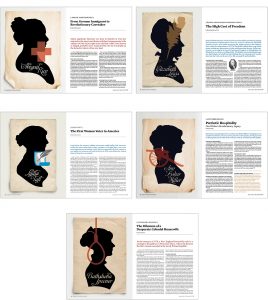 One of Hammock’s favorite parts of helping the Daughters of the American Revolution to publish American Spirit magazine is finding those little-known stories of women of the Colonial and early American period. Because these women are under-represented in historical accounts of the period, we also don’t know what many of them looked like! Portraits were painted of First Ladies Martha Washington, Abigail Adams and Dolley Madison, but obviously those were unique circumstances. Francis Lewis, like many of the signers of the Declaration of Independence, had a portrait painted, but his wife, Elizabeth Annesley Lewis, one of the March/April issue’s featured women, did not.
One of Hammock’s favorite parts of helping the Daughters of the American Revolution to publish American Spirit magazine is finding those little-known stories of women of the Colonial and early American period. Because these women are under-represented in historical accounts of the period, we also don’t know what many of them looked like! Portraits were painted of First Ladies Martha Washington, Abigail Adams and Dolley Madison, but obviously those were unique circumstances. Francis Lewis, like many of the signers of the Declaration of Independence, had a portrait painted, but his wife, Elizabeth Annesley Lewis, one of the March/April issue’s featured women, did not.
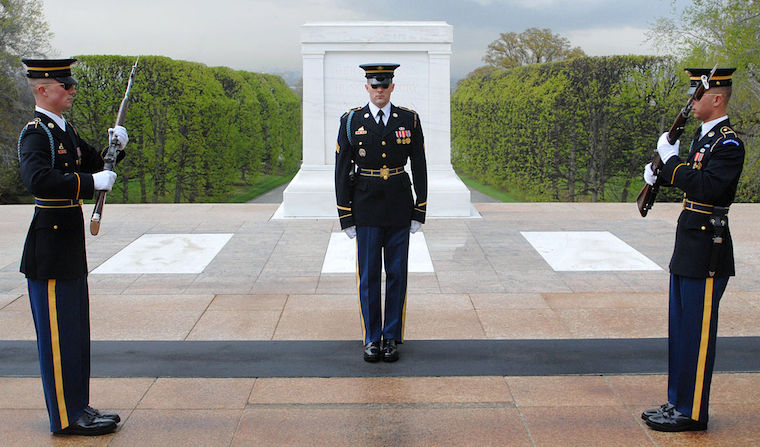
The simple, solitary act of laying a wreath at the foot of a fallen soldier’s grave or at the base of a monument to veterans will soon be replicated from coast to coast on November 11, Veterans Day. Better understanding this symbolic gesture was the focus of “Wreaths of Remembrance,” a feature by Hammock’s Emily McMackin for the November/December 2017 issue of American Spirit. Hammock proudly partners with the Daughters of the American Revolution (DAR) to publish American Spirit magazine and Daughters newsletter.
The following personal recollection about wreath-laying ceremonies was written by Jennifer Minus, National Chair of the DAR Magazine and U.S. Army Retired. This guest post first appeared on the Today’s DAR blog. 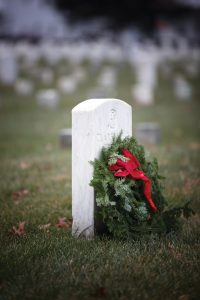
As I read the November/December 2017 American Spirit article chronicling wreath-laying ceremonies, I was struck by how often these ceremonies have figured in my own personal DAR story. I attended my first DAR wreath-laying when I was a Cadet at the U.S. Military Academy at West Point, and I represented the Margaret Corbin Forum (a Cadet Club) in the annual Memorial Service and Wreath-laying at the West Point Cemetery.
Hammock won three awards on behalf of its clients in the 2017 APEX Awards competition, including its 14th Grand Award for American Spirit, the magazine of the Daughters of the American Revolution. Hammock has been the DAR’s publishing partner since 2002. The Source, HealthTrust’s member magazine, also won an Award of Excellence.
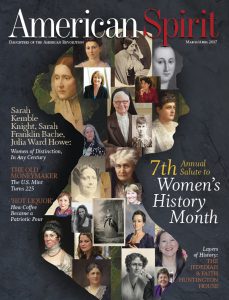 Projects that received awards were:
Projects that received awards were:
Grand Award for Feature Writing for “Long May She Wave: The Story of Annin Flagmakers” in the July/Aug 2016 American Spirit
Award of Excellence for the cover of the March/April 2017 American Spirit, featuring its seventh annual issue devoted to Women’s History Month
Award of Excellence for Custom-Published Magazines: The Source Q3 2016
APEX Awards are based on excellence in graphic design, editorial content and the ability to achieve overall communications excellence. APEX Grand Awards honor the outstanding works in each main category, while APEX Awards of Excellence recognize exceptional entries in each of the individual categories.
 Daughters of the American Revolution recently launched a new Facebook page for its magazine, American Spirit. Hammock has been a proud publications partner with DAR for more than 14 years, and we’re excited about this new way of interacting with our loyal and engaged audience.
Daughters of the American Revolution recently launched a new Facebook page for its magazine, American Spirit. Hammock has been a proud publications partner with DAR for more than 14 years, and we’re excited about this new way of interacting with our loyal and engaged audience.
The new page helps readers interact with other readers, receive updates on the latest issue and discover behind-the-scenes details of how stories were crafted.
The following is a guest post from Elizabeth Partridge, Magazine Publications Coordinator at the Daughters of the American Revolution (DAR). For 14 years, Hammock has proudly partnered with DAR to publish American Spirit magazine and Daughters newsletter. This post first appeared on the Today’s DAR blog.
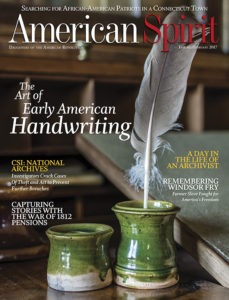 Documentation is such an important aspect of obtaining DAR membership, and many older records required for admission into the organization may be difficult to read, require extensive preservation or may even be lost or missing. With that in mind, the January/February 2017 issue of American Spirit features stories that spotlight the importance of historical documents and resources and also highlights the work of archivists who preserve and protect them.
Documentation is such an important aspect of obtaining DAR membership, and many older records required for admission into the organization may be difficult to read, require extensive preservation or may even be lost or missing. With that in mind, the January/February 2017 issue of American Spirit features stories that spotlight the importance of historical documents and resources and also highlights the work of archivists who preserve and protect them.
Our cover story, “The Art of Early American Handwriting,” details the history of early American script and offers a few tricks to decode historical handwriting. The most important rule? Don’t assume anything! A feature on the War of 1812 Pensions shows how these vital records provide a direct link to the past and what several organizations including Ancestry.com, the National Archives and Fold3 are doing to help preserve and digitize them.
Hammock won five awards on behalf of its clients in the 2016 APEX Awards competition, including its 13th Grand Award for American Spirit, the magazine of the Daughters of the American Revolution. Hammock has been the DAR’s publishing partner since 2002. Other award winners were The Source, HealthTrust’s member magazine, and the H2U newsletter, a custom-published health resource for members in select HCA hospitals.
Projects that received awards were:
Grand Award for Feature Writing for “A Lasting Legacy: DAR Schools” in the July/Aug 2015 American Spirit. (Written by Hammock’s own Emily McMackin)
Award of Excellence for the design and layout of the May/June 2015 American Spirit
Award of Excellence for Custom-Published Magazines: The Source Q4 2015
Award of Excellence for Feature Writing for “Combating the Antibiotic Resistance Crisis,” in the Q4 2015 issue of The Source (Written by Hammock’s own Megan Hamby)
Award of Excellence for Custom-Published Newsletters: H2U’s October 2015 newsletter
APEX Awards are based on excellence in graphic design, editorial content and the ability to achieve overall communications excellence. APEX Grand Awards honor the outstanding works in each main category, while APEX Awards of Excellence recognize exceptional entries in each of the individual categories.
Pat Summitt
 Pat Summitt, the winningest basketball coach in NCAA Division 1 history, passed away today, June 28, 2016, at the age of 64. The head coach for the University of Tennessee Lady Vols for 38 years, she retired with a record of 1,098–208. She led the Lady Vols to eight NCAA championship titles, and they were the runners-up five other times.
Pat Summitt, the winningest basketball coach in NCAA Division 1 history, passed away today, June 28, 2016, at the age of 64. The head coach for the University of Tennessee Lady Vols for 38 years, she retired with a record of 1,098–208. She led the Lady Vols to eight NCAA championship titles, and they were the runners-up five other times.
Summitt was known for her stony glare on the court sidelines, but players remember her for the impact she made on their lives, education and athletic careers. In addition to her coaching record, Summitt also boasted a 100 percent graduation rate among players.
In the March/April 2003 issue of American Spirit, which Hammock publishes with our client, The Daughters of the American Revolution, writer Dennis McCafferty spoke with Summitt about her life, accomplishments and coaching philosophy. Continue reading:
 The May/June issue of American Spirit*, the national magazine of the Daughters of the American Revolution (DAR), visits Lasell Hall, owned by Schoharie DAR Chapter, Schoharie, N.Y. The home, in DAR’s hands since 1912, was severely damaged during the flooding from 2011’s Hurricane Irene. The building has become a signature restoration project for FEMA, but that agency wasn’t the only one to lend funds or a helping hand. Chapter members and the entire community came together to restore the circa-1795 home, including reinstating the original floor plan and many historic paint colors.
The May/June issue of American Spirit*, the national magazine of the Daughters of the American Revolution (DAR), visits Lasell Hall, owned by Schoharie DAR Chapter, Schoharie, N.Y. The home, in DAR’s hands since 1912, was severely damaged during the flooding from 2011’s Hurricane Irene. The building has become a signature restoration project for FEMA, but that agency wasn’t the only one to lend funds or a helping hand. Chapter members and the entire community came together to restore the circa-1795 home, including reinstating the original floor plan and many historic paint colors.
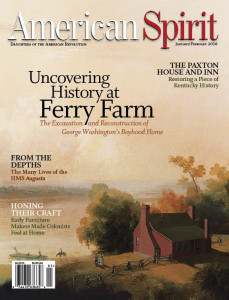 American Spirit*, the national magazine of the Daughters of the American Revolution (DAR), has a strong track record of spotlighting unique preservation efforts of DAR members and others dedicated to restoring the nation’s iconic places.
American Spirit*, the national magazine of the Daughters of the American Revolution (DAR), has a strong track record of spotlighting unique preservation efforts of DAR members and others dedicated to restoring the nation’s iconic places.
For the January/February 2016 issue, our cover subject is Ferry Farm, the site of George Washington’s boyhood home. After spending almost a century as an endangered site, Ferry Farm is rising again, as a team of archaeologists, historians and volunteers with the George Washington Foundation work to reconstruct the circa-1740 house and uncover new information about the early life of America’s first commander in chief. DAR members have so far raised more than $125,000 for the restoration.
Because of American Spirit’s focus on the lives of Patriots, we don’t often talk about the lives of Loyalists. Some faced mob violence and property seizures because of their allegiance to the Crown, and others changed their allegiances throughout the war depending on their treatment. Fearing persecution after the Revolutionary War, thousands of Loyalists fled to Canada, where they faced new hardships before becoming a vital part of the fabric of their new country.
We’ll hear “The Star-Spangled Banner” played a number of times over the next few days, and no doubt, we’ll think of fireworks when we hear “the rockets’ red glare/the bombs bursting in air.”
But, as we explain in the July/August issue of American Spirit, which Hammock publishes with the Daughters of the American Revolution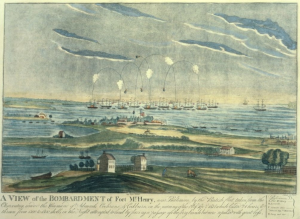 , the rockets that Francis Scott Key immortalized weren’t playthings. They were a British system of military rocketry that largely failed to carry out its mission against Fort McHenry, the fort that defended Baltimore Harbor during the War of 1812.
, the rockets that Francis Scott Key immortalized weren’t playthings. They were a British system of military rocketry that largely failed to carry out its mission against Fort McHenry, the fort that defended Baltimore Harbor during the War of 1812.
Designed by the English inventor Sir William Congreve and modeled on rockets used against the British in India by Indian troops, the rockets that flew over Fort McHenry weighed about 32 pounds and had two major deficiencies—they were unreliable, inaccurate and also tended to explode prematurely.
The rockets fired on September 13, 1814, were launched from the British ship Erebus, and ultimately did little physical damage, though the screaming, wildly gyrating rockets terrified American defenders.
Congreve’s rockets consisted of an iron tube packed with propellant and a conical warhead, with three interchangeable payloads including incendiary devices, explosives and case shot—anti-personnel devices that exploded and sprayed iron balls in a lethal cloud. They ranged in size from 3 to about 32 pounds, and could be fired from ships as well as by troops on the ground.